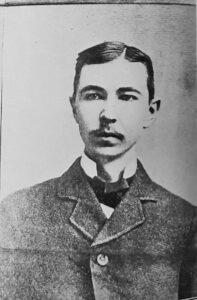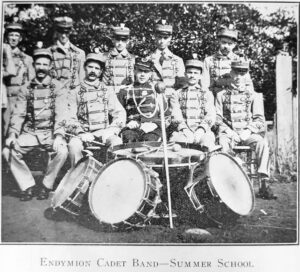Was Charles Bean a Conman?
By Becky Chapin, Archivist
Charles Bean Jr. was born in Marion, New York on April 21, 1863 to Charles and Cloa Maria Danford Bean. Charles Sr. was born in England and came to Sodus at the age of 10; eight years later the family moved to Geneva. Charles Sr. supplemented his early education at the Geneva Academy and later attended lectures at the Geneva Medical College after being influenced by his brother-in-law who was a surgeon in the US Army. He moved to NYC and this is where he met and married Cloa Danford. Cloa was the granddaughter of Joshua Danford who was a sergeant in Colonel Reed’s New Hampshire regiment during the American Revolution.
Their only son, Charles Jr., spent his early years in NYC, educated for a short time in Prattsburgh and moved with his family to Geneva in 1874. At age 12, he received his preparatory education for college at the Union School from which he moved to Hobart College to receive his Bachelor of Science. After receiving a Bachelor of Philosophy from Syracuse University and a Master of Arts from Allegheny College, Charles studied law with his uncle Major John E. Bean who had been practicing in Geneva for thirty years.
Charles lived most of his life in Geneva, though he maintained family property in Prattsburgh. At the time of his death in 1938, Syracuse University published a piece in their Alumni News Magazine listing all the organizations Charles was involved in, for a total of 28. About half of them were fraternal organizations, his father also being an ardent member of some masonic orders, which may explain a few odd occurrences surrounding him.
While at Hobart College, he became a member of the Hobart Cadets and studied military tactics under the tutelage of a United States officer. This may be why he decided to start the Endymion Military Preparatory School that would conduct classes downtown. He established, and wanted to permanently endow, the military academy and a boarding school for the instruction of young men. Unfortunately, when he applied for a charter in 1884 the state rejected his application.

Maple Hill, 1907. Built by Phineas Prouty Sr., Maple Hill became the Lafayette Inn in the mid-20th century.
Despite this, he continued to “operate” the school until 1896-7 when lack of funds caused its closure. Instead, he transferred the school to his estate at Maple Hill and renamed it Elmwood Priory. Various photographs as well as diplomas issued and signed by Charles in our archive show that young men were indeed living in this property and “matriculated.” Whether the school was legitimate or not has become the subject of much discussion in the past and present, but it eventually closed around the outbreak of World War 1.
Charles published school catalogues and other information, complete with pictures of classes and marching bands, class lists were found painted on walls, the newspaper published graduation announcements and commencement exercises. Class mottos were carefully lettered over doorways, and precepts inscribed on walls of passageways. However, many people believe that the school only existed in Bean’s mind.
City Historian Malcolm Johnston conducted his own research in the 1940s, contacting Charles’ neighbor Dr. JA Spengler, a relative Frank Rupert, and the successive owner of Maple Hill Richard Shreve. Dr. Spengler recounted his memories of Charles in 1945 as having an imaginative mind and questioned whether the school was chartered at all. Upon Spengler’s graduation from Cornell, Charles presented him with a bronze medallion for the school despite Spengler never actually having attended (we have one such medallion in our collection). And though Spengler gave several lectures for Endymion’s students, he found out that Charles was listing Spengler as a trustee of the school without his permission; discovering this after a few publications written by Charles were published with his name listed not only for the school but also as an officer for other fraternal orders. After Charles’ death, Spengler found out he was named executor of the will without his knowledge yet again.
Richard Shreve bought Maple Hill from Charles in 1923 and was probably shocked at the interior of the house and its outbuildings. He relayed the information to Johnston via a letter in 1943, remembering that Charles was only too happy to discuss the school and the home at the turn of the century, but twenty years later Charles was reluctant to speak at all about the meaning of what he built at Maple Hill. Other “graduates” were also tightlipped about their experiences which shrouded the school in more mystery.
The interior of the house was altered by Charles to accommodate the school, in addition to the cattle barn which remained on the property from the Charles Sr., Shreve described the inside of the barn and home. The Lodge room was a painted red floor, with lighter lines painted to designate lanes and positions, and the walls were painted with 12-15 different colors. Inside a small room were the painted names of supposed officers of a supposed Knights of Cyprus (we’ll come back to this); another small room was painted “Neophytes.”
The second floor of the barn held a Labyrinth, consisting of doors which opened one way or two ways, staircases, arches, different levels, closed booths, and a Japanese pagoda. The pagoda had a sign which claimed it had been brought to America by a member of the embassy staff, but Shreve felt the wood looked like New York pine and the nails didn’t look right either. Shreve felt this Labyrinth was intended to be or may have been a hazing room for the Neophytes who were meant to make it to the exit, which itself looked like steps from King Solomon’s Temple.
Shreve recalled a cement block which had been installed in memory of Canon Scott (of whom I have no record), a gymnasium that also had a stage for theatrical use, a coat room, dining room, many classrooms, and a swimming pool. He also took down the names of the Knights of Cyprus and questioned them, but none of them seemed to know what the organization was nor could Shreve find proof that it existed elsewhere.
Next month will be Part 2 and will explore more mysterious happenings.




Location of the “school?”
Maple Hill became Lafayette Inn which was where Ponderosa was before the car wash currently being built.
Becky,
Very interesting information about Charles Bean Jr. Thanks for doing the research. Old Timers, me included, often refer to the area around the new car wash and Cobblestone as “Bean’s Hill”.
Yes, it said somewhere in his files that Charles wanted it named such for his father.